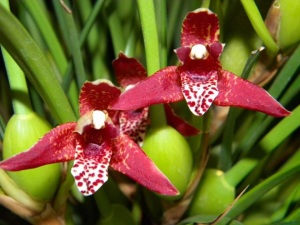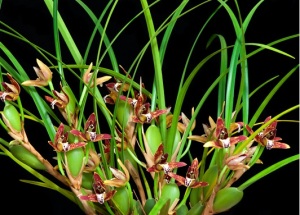Maxillaria tenuifolia is a epiphytic orchid from Central America, typically found growing in trees, but sometimes can also be found seen on the ground. Its common name is the coconut orchid due to the fragrance of the flowers. The flowers, although brightly colored, are relatively small (1”) and not particularly showy. In fact sometimes you would miss the blooms if it wasn’t for the smell of coconut oil with maybe a hint of cinnamon wafting through the patio. When it flowers, I like to bring the plant inside so we can contain the aroma to the house.
Many people who do not grow orchids think there is only one type of orchid: the well-known Cattleya or corsage orchid. There are actually around 30,000 different orchids including orchids that grow on the ground or on rocks, some that can even flower underground, and a even few located near the arctic circle. I was amazed to discover recently that Utah has 14 orchids, of course they go dormant during the winter. I think we have around 140 different species in Florida, although only a handful of epiphytic types here in Central Florida.
I bought my first coconut orchid from a vendor at the Fernandina Shrimp Festival about 10 years ago. It was an impulse purchase. It was late on Sunday and everyone was packing to go. I think I paid 8 bucks for it–all the cash I had on-hand after buying some nice artwork and shrimp, and some nice earrings for my wife, Kat. The vendor wanted more but was willing to part with it rather than pack it back up and haul it home. It was rather small. Maybe three or four bulbs, but it did have two flowers with that coconut fragrance that made me want it.
This was another relatively easy orchid for me to grow. It doubled in size every year and I was soon giving cuttings away or trading for other orchids that I didn’t have in my collection, until one year, when I received some bad advice about my potting media. I should’ve heeded the motto “If it ain’t broke, don’t fix it”. The roots stayed too wet in sphagnum moss and the slugs got to it. When I finally figured out what was happening to my plant, I had to cut out the dead parts which left me with a plant half its original size. I have tried regular orchid bark mix with perlite and have used a mix with coconut husk chips. I find the orchid bark with perlite mix works best for me. It’s allows me to water them a little more often which keeps the plants cooler in the summer. But I have used sphagnum to start cuttings.
Some years my tenuifolia hung in the backyard oak tree. Other times I had it on my screened patio. It seemed to like the tree best. It may have received too much light on the patio and when it was in the tree apparently it also stayed away from the slugs. I water it thoroughly with the house if it hasn’t rained in awhile. Tenuifolias prefer to stay on the moist side, just drying out between watering’s, but don’t let them get bone dry, at least not during the hot summer months. I fertilize them every week, maybe a little on the heavy side.
These plants go through a dormant period, where their growth slows but they still need care. You should reduce watering and fertilizer. The amount varies depending on how much light they receive and how warm it is. The warmer and brighter locations will need water more often, cooler and darker areas (but not too dark) can go longer between feedings. Some people insist on stopping fertilizing until the spring–or at least switching to a bloom booster and Epsom salts regime.
 I bring mine inside when the weather gets down to 50o. I usually bring them into the garage during cold spells and move them back outside whenever it warms up (although this is getting to be a chore when you have 140 varieties of orchids, some as large as 2 feet in diameter). One year after my daughter moved out I put them in her room. It s a south-facing room and although they didn’t get direct sun, I think it was a little too warm. They didn’t flower well the next year.
I bring mine inside when the weather gets down to 50o. I usually bring them into the garage during cold spells and move them back outside whenever it warms up (although this is getting to be a chore when you have 140 varieties of orchids, some as large as 2 feet in diameter). One year after my daughter moved out I put them in her room. It s a south-facing room and although they didn’t get direct sun, I think it was a little too warm. They didn’t flower well the next year.
All and all, I have found this orchid to be one of the easiest to grow. For that reason, it’s one I recommend to new hobbyists. Everyone always loves the fragrance . . . except when mine is in bloom I get this urge to eat some macaroons.

